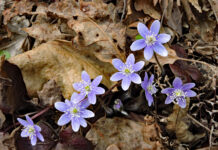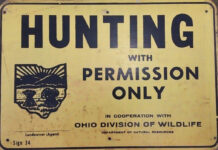When fall colors begin to reveal themselves, it’s time to plant woody vines, small trees and perennial wildflowers.
Being in the ground for five or six months allows plants to acclimate to local conditions and leads to vigorous spring growth. Furthermore, nurseries, garden centers and nature centers often offer these species at sale prices in September and October.
Trumpet creeper
My interest in woody vines began almost 30 years ago when I planted several sprigs of trumpet creeper. Its large orange, trumpet-shaped flowers are reliable sources of nectar, and hummingbirds love it.
It took my trumpet creeper five years until it finally bloomed.
Trumpet creeper grows rapidly and aggressively, can cover small buildings in just a few years, and can reach heights of 30 feet. Its compound leaves range from 3 to 12 inches and consist of seven to 11 toothed leaflets.
Its orange flowers yield 4- to 8-inch pods which dry and split to release many small, winged seeds.
Another virtue of woody vines is that many provide vivid fall colors. The leaves of Virginia creeper are among the first to turn red on tree trunks, fence posts and old buildings.
American bittersweet leaves will soon turn yellow, but its bright orange fruits will be more conspicuous. Trumpet creeper and grapevines lack vibrant fall colors but are easy to notice as they invade the canopies of small trees and shrubs.
Virginia creeper doesn’t need an invitation to invade backyards. Dozens of birds love its small dark blue berries, which suggest miniature grapes, and its seeds are spread via bird droppings.
Its flowers are small, green and inconspicuous, but its compound leaves typically consist of five leaflets arising from a central point.
Occasionally leaves may have only three leaflets making it easy to confuse with poison ivy (“leaflets three, let it be”).
American bittersweet is a popular decoration for fall table settings. Its seeds are inside orange capsules and covered by a bright red fleshy outer skin.
Its leaves turn yellow in the fall and are 2 to 5 inches long with wavy teeth.
Grapevines
Grapevines climb high and aggressively overtop small trees and shrubs. Grasping tendrils extend from the stems to give the vine a firm grip on its anchor.
Grape leaves are heart-shaped and can span 9 inches. Grapes can be sweet or sour depending on the species, but all are favorite foods of dozens of birds and mammals.
Grapevine thickets that envelop stands of small trees provide excellent nesting cover for birds such as cardinals, song sparrows, indigo buntings, catbirds and brown thrashers.
Furthermore, grapevine bark sheds in long strips that makes great nesting material.
Poison ivy
Even poison ivy is beneficial to wildlife, but it’s a serious problem for many people. It causes a severe itchy rash that can persist for 10 days.
Fortunately, many people lose their sensitivity to poison ivy oil (urushiol) as they get older. This irritating oil is present in all plant parts all year long, and it can remain active on dead plant parts for up to five years.
Burning or weed-eating poison ivy can release molecules of urushiol into the air.
Poison ivy and its leaves are highly variable. The plant grows as a vine, a shrub, or even a small tree, and its leaves can be round, oval, or elongate with smooth or toothed margins.
Older stems and climbing forms are covered with fine, aerial rootlets. Poison ivy is a chameleon, but its compound leaves are shiny and almost always consist of three leaflets.
People should avoid poison ivy at all costs, and I certainly do not suggest planting it, but dozens of birds eat its small white fruits.
Finally, while you’re in a planting mood, here are just a few perennial wildflowers and trees that do well when planted in the fall.
Trumpet honeysuckle, butterfly milkweed, impatiens, columbine, monarda, ironweed and Joe-Pye weed are great nectar sources for butterflies and hummingbirds.
Serviceberry, crabapples, persimmons, pawpaw and sassafras are small trees that can yield large quantities of fruits and berries for a variety of birds and other wildlife.













Grape vines, the curlies, can get to three or four feet at the base and two hundred feet high. The most I have seen is maybe 18 inches. ^ The Kings grew straight up and were six to seven feet at base. They eventually fell to the ground and could make bridges.They only grew in North America. Grape vine bridge remnants are most noticeable in public hunting lands. They went to the charcoal industry and were lost by the Civil War.. There are supposed to be places in old strip land, where these still exist. The bittersweet woods with an early snowfall and green moss, and a black jaguar and red panda was once a cliche. Red honeysuckle reached 250 feet and grew up a tree called Big Purple. The Chinese only wanted the smaller varieties. Sweet autumn clemati stretched for miles.
This happened when there were big bird flocks and lots of miasmas that dispersed the floating bird droppings.